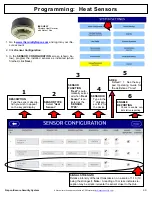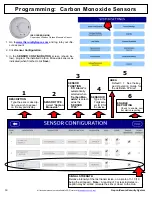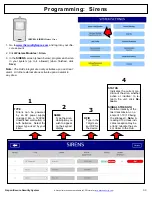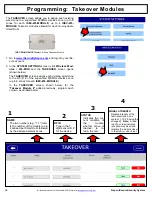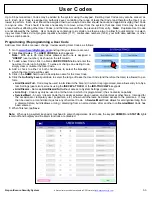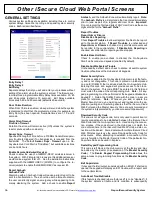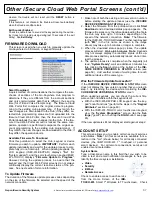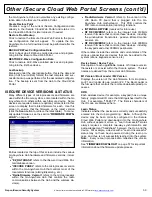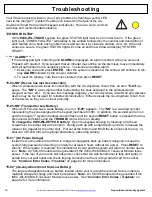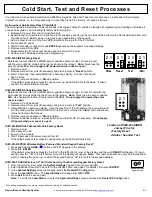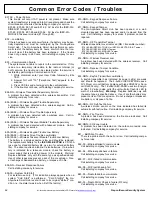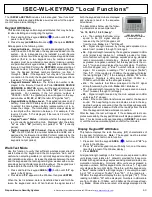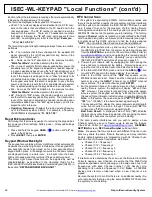
Napco iSecure Security System
All technical manuals are available in PDF format at
tech.napcosecurity.com
63
The
ISEC
-
WL
-
KEYPAD
includes internal keypad "local functions"
that display certain keypad attributes as well as allow for the adjust-
ment of some internal settings.
Keypad Attributes
This function displays certain keypad attributes that may be help-
ful when installing and configuring the system.
1.
Press and hold the keypad
AREA
(
) button until "
LF
" ap-
pears in the Window.
2.
Press the keypad
AREA
button once (
), then press
ENTER
.
Data appears in the following order:
•
Keypad Address
-
Displays the address assigned by the iSe-
cure Cloud Web Portal when the keypad was added into the
system. Up to 6 keypads may be installed in each iSecure
system, and each must be assigned a unique Keypad Address
number (that is, no two keypads may be numbered alike).
Keypads must be numbered consecutively (missing numbers
are permitted after keypad delete). Keypads are added to the
iSecure Cloud Web Portal in the
KEYPADS
screen starting at
Address number 3, and with up to 6 keypads allowed per sys-
tem, the Keypad Address numbers therefore run from 3
through 8.
Note:
If the keypad is "out of system" (no wireless
connection to the Hub), the Keypad Address will appear after a
lowercase "o" (to signify "out of system").
•
Keypad Firmware Version
-
The full version number is dis-
played in the iSecure Cloud Web Portal
ISECURE DEVICE
VERSIONS & STATUS
screen, but the keypad displays only
partial version numbers after the letters "
rE
", and in several
segments. For example, if the full version number is
"00.02.38 / 00.09", the (partial) version will appear in the key-
pad window as "
rE
,
02
,
d
,
38
" (the letter "
d
" signifies "dot").
•
Keypad Battery Voltage Level
-
The keypad requires one 3V
battery. A second 3V battery can be installed and is used only
to extend the time between battery replacements, not to in-
crease the voltage. The total battery level is always displayed
in two digits with a decimal in between. For example, if the
level is 3.0 volts, "30" is displayed; if the level is 2.9 volts, "29"
is displayed.
•
Keypad "Learn" Status
-
Indicates whether the keypad is or
is not currently paired with a Hub. Displayed after the letters
"
Lr
" as either "
00
" (currently not paired) or "
01
" (currently
paired).
•
Radio Frequency (RF) Channel
-
Displayed after the letters
"
CH
", the RF Channel is a number between
0
and
32
, and is
assigned by the iSecure Cloud Web Portal or randomly by the
Hub when the keypad was paired (zero assigned when the
keypad is not yet paired).
Walk Test Mode
Use this function to verify that sufficient wireless signal strength
exists between the keypad and the Go
-
Anywhere Hub, and is
useful when selecting suitable (or optimal) keypad mounting and
Hub installation locations. Increase the distance between the Hub
and the keypad and the radio signal will grow weaker with a corre-
sponding slowing of data rates and throughput. The keypad must
be learned into the Hub for this test mode to function.
1.
Press and hold the keypad
AREA
(
) button until "
LF
" ap-
pears in the Window.
2.
Press
4
and "
F4
" appears in the Window, then press
ENTER
.
When the test is initiated, data is transferred back and forth be-
tween the keypad and Hub. When finished, the signal levels of
both the keypad and Hub are displayed
and a beep is heard in the sequence
listed below.
The descriptions below use the follow-
ing characters as an example result:
"
LL
,
10
,
36
,
PL
,
10
,
45
, (
beep
)".
•
LL
-
The numbers that follow corre-
spond to the RF signal strength
received by the (LCD) keypad sent
from the Hub.
Note:
LL
= "
L
CD
L
evel".
•
10
-
Signal strength received by the keypad expressed on a
scale from 1 (weaker) through 10 (stronger).
•
36
-
Signal strength received by the keypad expressed in dBm
units (signal level relative to 1 milliwatt), provided for those
more familiar with signal readings expressed using standard
radio communication terminology. Normally, dBm units are
expressed in negative numbers, but this keypad omits the mi-
nus ("
-
") sign and only displays the two right digits. Therefore,
with this keypad only, a "lower" number reflects a stronger
signal. For example, a reading of "30" is stronger ("better")
than "55". If the reading is
-
102dBm, the keypad will display
the two right digits ("02"). If the reading is
-
99dBm, "99" will be
displayed. Numbers in dBm scale are from
-
30dbm to
-
105dbm, with
-
30dbm as the strongest reading.
•
HL
-
The numbers that follow correspond to the RF signal
strength received by the Hub.
Note:
HL
=
H
ub
L
evel.
•
10
-
Signal strength received by the Hub expressed on a scale
from 1 (weaker) through 10 (stronger).
•
45
-
Signal strength received by the Hub expressed in dBm
units (see "36", above).
•
Beep
-
If the current data transfer was successful, the beep will
sound. The beep failing to sound indicates a loss in the key-
pad/Hub wireless connection; thus the readings subsequently
displayed without a beep will reflect the readings from the last
time the keypad/Hub had a wireless connection.
After the beep, the test will repeat. If the subsequent test com-
pletes successfully, the keypad Window will display updated num-
bers. This test mode will keep repeating until
RESET
is pressed
or until the mode automatically times out after four minutes.
Display Keypad RF Attributes
This feature displays the radio frequency (RF) characteristics of
the keypad, for reference.
Note:
The keypad must be learned
into the Hub for this test mode to function.
1.
Press and hold the keypad
AREA
(
) button until "
LF
" ap-
pears in the Window.
2.
Press "
0
" and all keypad icons will briefly turn on at the same
time (this is a test of the Window display).
3.
Press
ENTER
.
All signal strength readings in this function are expressed in dBm
units (signal level relative to 1 milliwatt), provided for those more
familiar with signal readings expressed using standard radio com-
munication terminology. Normally, dBm units are expressed in
negative numbers, but this keypad omits the minus
("
–
")
sign and
only displays the two right digits. Therefore, with this keypad only,
a "lower" number reflects a stronger signal. For example, a read-
ing of "30" is stronger ("better") than "55". If the reading is
-
102dBm, the keypad will display the two right digits ("02"). If the
reading is
-
99dBm, "99" will be displayed. Numbers in dBm scale
are from
-
30dbm to
-
105dbm, with
-
30dbm as the strongest read-
ing.
Note:
Unless otherwise noted, all readings displayed in this
ISEC
-
WL
-
KEYPAD "Local Functions"
ISEC
-
WL
-
KEYPAD
Wireless Battery
-
Operated
Standard Keypad

